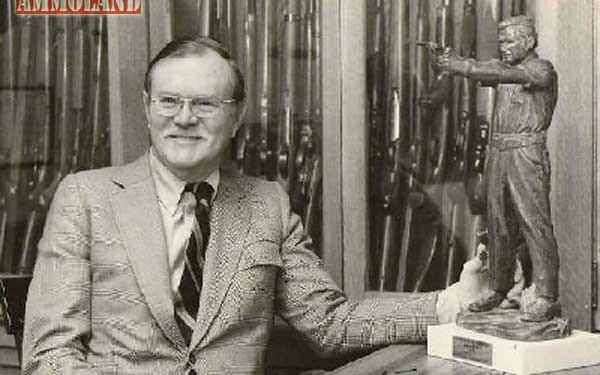
U.S.A. –-(AmmoLand.com)- On June 21, 1916, William Batterman Ruger was born in Brooklyn. He would go on to lend his name to one of the iconic arms companies of the 20th century.
We’ll fast-forward through the first 30-odd years of Ruger’s life (he attended – but did not graduate – college; got married; had a son; dabbled in machine gun designs at Springfield Armory) and pick up the story in January 1949. The timing couldn’t have been better for William Ruger when he and Alexander Sturm became business partners that month.
Ruger had been making hand tools for the past few years, but business wasn’t going well. He was $40,000 in debt and just about ready to close up shop. Ruger showed Sturm a prototype of something new that he was working on, harking back to his previous life with the military and arms development. Sturm liked what he saw and agreed to bankroll the project with $50,000. Immediately, the two men began laying the foundation for what would become one of the largest firearms companies in the United States.
The first Ruger “factory” was in a small, unassuming building affectionately dubbed the “Red Barn” across the street from a railroad depot. The company’s first offering was equally unassuming: a semi-automatic .22-caliber pistol designed for plinking. It would become known as the Ruger Standard.
Things moved quickly. Onn October 6, 1949, the first batch of production guns were officially shipped from the factory. By January 1, 1950, a total of 1,138 Ruger Standard pistols had been completed and shipped to waiting customers. By February 1950, Sturm, Ruger & Company had a backorder of 5,000 units and a production capacity of 900 guns per month. By summer, the backlog had grown to 9,000 units and production capacity had only risen slightly to 1,000 guns per month.
Within a year, the little startup company from Connecticut had gained traction and would continue to advance at a rapid pace. There was, however, an unexpected blow just around the corner.

Alexander Sturm contracted viral hepatitis and died unexpectedly in November 1951 at the age of 28. The company’s heraldic eagle logo that is today instantly recognizable was originally designed by Sturm. Paying homage to his fallen business partner, Bill Ruger changed the color of the eagle logo from red to black. It wasn’t until 1999 and the celebration of the Ruger Standard’s 50th anniversary that the logo would return to red.

Given the popularity of westerns and six-guns in the 1950s, Ruger introduced their first revolver in 1953. With its success, the company continued to offer a wider variety of firearms. The Single-Six, Blackhawk, and Bearcat – all revolvers – were introduced by the end of the decade.
Rifles were next up in the Ruger repertoire. The Deerstalker, 10/22, No. 1, and M77 models were all added to the lineup in the 1960s.
The company’s only flop came in 1969/70, but it wasn’t a gun. Bill Ruger collected high-end antique cars. In that vein, he designed the Ruger Tourer, a car based on the luxurious Bentley. Bill soon found out that he read the market wrong – a rare occurrence. Only two were ever made, and the company’s focus turned back to guns.
Because of the success and popularity of the Ruger brand, it became publicly-traded for the first time in 1969.

The 1970s saw the birth of the “-Six” revolver series, the “New Model” transfer bar revolver, the Old Army black powder revolver, the Mini-14 rifle, and the Red Label O/U shotgun. By 1979 – the company’s 30th anniversary – Ruger had seen tremendous success and growth.
In 1989, Bill Ruger personally drew the ire of many in the gun community when he wrote letters to Congress proposing a ban on “high capacity” magazines. Gun owners have long memories, and some still won’t own a Ruger firearm to this day because of that proposal.
When the company celebrated 50 years in 1999, it had already cemented its place in firearms history. Quite literally, tens of millions of gun owners had Ruger firearms in the field, in their safes, on the range, and in their trucks.
In 2000, Ruger finally retired at the age of 84. His son took over as chairman and CEO of the company. Just two years later, Bill Ruger died in 2002, having spent 53 years involved in the operations of the company he helped found. His son, Bill Ruger, Jr., passed in 2018 after 42 years of employment with his father’s company. Even though no one with the Ruger name has officially run the company in more than a decade (Jr. retired in 2006), the company remains a force to be reckoned with in the American firearms market.
About Logan Metesh
Logan Metesh is a historian with a focus on firearms history and development. He runs High Caliber History LLC and has more than a decade of experience working for the Smithsonian Institution, the National Park Service, and the NRA Museums. His ability to present history and research in an engaging manner has made him a sought after consultant, writer, and museum professional. The ease with which he can recall obscure historical facts and figures makes him very good at Jeopardy!, but exceptionally bad at geometry.


The best thing to happen to Ruger as a company was the passing of Bill Ruger.
In the order of which they were acquired these are the Rugers I have owned over the last 48 years: Mod 77 in 6mm Rem, Mod 77 in 30-06, Super Blackhawk 71/2″, second Mod 77 30-06, Blackhawk 357/9mm 6″, Super BH Stainless 10 1/2″, Super BH Blued 10 1/2″, KP95DAO, KP95DC, KP97DAO, Speed Six 3″ 357, LCP. I still have every one of them except for the rifles and the 7 1/2″ SBH.
Bill Ruger was a true, firearms manufacturing pioneer in his heyday. RIP Bill Unfortunately, manufacturing and leading a company into a sustainable future are two completely different things. His stubborn, 60s-Fudd-Style of management was severely shortsighted, and eventually led the company into the dustbin of irrelevance. “The best way to address the firepower concern is therefore not to try to outlaw or license many millions of older and perfectly legitimate firearms (which would be a licensing effort of staggering proportions) but to prohibit the possession of high capacity magazines. By a simple, complete and unequivocal ban on large capacity magazines,… Read more »
Yes, it truly is a case of, “Oh, what might have been.”
Finally able to comment. One thing that I can say about anything Ruger; they are built like a tank. Through the years I have owned several Rugers so I know this to be true. Also, their stainless steel doesn’t rust life, for instance, a Sig does. I sweat. I have owned both,I know this is true.
I didn’t know about Ruger’s note to Congress about hi-cap magazines. What a sad,mislead proposal especially comming from a otherwise brilliant man.
Arm up, carry on.